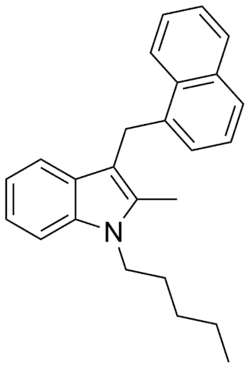JWH-196 |
|
| Legal status |
|
|---|
|
2-Methyl-3-(1-naphthalenylmethyl)-1-pentyl-1H-Indole
|
| CAS Number | |
|---|
| ChemSpider | |
|---|
| UNII | |
|---|
|
| Formula | C25H27N |
|---|
| Molar mass | 341.498 g·mol−1 |
|---|
| 3D model (JSmol) | |
|---|
CCCCCn1c(c(c2c1cccc2)Cc3cccc4c3cccc4)C
|
InChI=1S/C25H27N/c1-3-4-9-17-26-19(2)24(23-15-7-8-16-25(23)26)18-21-13-10-12-20-11-5-6-14-22(20)21/h5-8,10-16H,3-4,9,17-18H2,1-2H3 Key:LDTJKFUAZQDSQS-UHFFFAOYSA-N
|
JWH-196 is a synthetic cannabinoid receptor ligand from the naphthylmethylindole family. It is the indole 2-methyl derivative of related compound JWH-175, and the carbonyl reduced analog of JWH-007. The binding affinity of JWH-196 for the CB1 receptor is reported as Ki = 151 ± 18 nM.[1]
In the United States, all CB1 receptor agonists of the 3-(1-naphthylmethane)indole class such as JWH-196 are Schedule I Controlled Substances.[2]
See also
References
- ^ Huffman JW, Mabon R, Wu MJ, Lu J, Hart R, Hurst DP, Reggio PH, Wiley JL, Martin BR (2003). "3-Indolyl-1-naphthylmethanes: new cannabimimetic indoles provide evidence for aromatic stacking interactions with the CB1 cannabinoid receptor". Bioorg. Med. Chem. 11 (4): 539–549. doi:10.1016/s0968-0896(02)00451-0. PMID 12538019. S2CID 29107765.
- ^ 21 U.S.C. § 812: Schedules of controlled substances
|
|---|
Phytocannabinoids
(comparison) | | Cannabibutols | |
|---|
| Cannabichromenes | |
|---|
| Cannabicyclols | |
|---|
| Cannabidiols | |
|---|
| Cannabielsoins | |
|---|
| Cannabigerols | |
|---|
| Cannabiphorols | |
|---|
| Cannabinols |
- CBN
- CBNA
- CBN-C1
- CBN-C2
- CBN-C4
- CBNM
- CBND
- CBNP
- CBVD
|
|---|
| Cannabitriols | |
|---|
| Cannabivarins | |
|---|
| Delta-3-tetrahydrocannabinols | |
|---|
| Delta-4-tetrahydrocannabinols | |
|---|
| Delta-7-tetrahydrocannabinols | |
|---|
| Delta-8-tetrahydrocannabinols | |
|---|
| Delta-9-tetrahydrocannabinols | |
|---|
| Delta-10-Tetrahydrocannabinols | |
|---|
| Delta-11-Tetrahydrocannabinols | |
|---|
| Miscellaneous cannabinoids | |
|---|
| Active metabolites | |
|---|
|
|---|
| Endocannabinoids | |
|---|
Synthetic
cannabinoid
receptor
agonists /
neocannabinoids | Classical cannabinoids
(dibenzopyrans) | |
|---|
Non-classical
cannabinoids | |
|---|
| Adamantoylindoles | |
|---|
| Benzimidazoles | |
|---|
| Benzoylindoles | |
|---|
| Cyclohexylphenols | |
|---|
| Eicosanoids | |
|---|
Indazole-3-
carboxamides | |
|---|
| Indole-3-carboxamides | |
|---|
| Indole-3-carboxylates | |
|---|
| Naphthoylindazoles | |
|---|
| Naphthoylindoles | |
|---|
| Naphthoylpyrroles | |
|---|
| Naphthylmethylindenes | |
|---|
| Naphthylmethylindoles | |
|---|
| Phenylacetylindoles | |
|---|
| Pyrazolecarboxamides | |
|---|
Tetramethylcyclo-
propanoylindazoles | |
|---|
Tetramethylcyclo-
propanoylindoles | |
|---|
| Others | |
|---|
|
|---|
| Allosteric CBRTooltip Cannabinoid receptor ligands | |
|---|
Endocannabinoid
enhancers
(inactivation inhibitors) | |
|---|
Anticannabinoids
(antagonists/inverse
agonists/antibodies) | |
|---|
|
